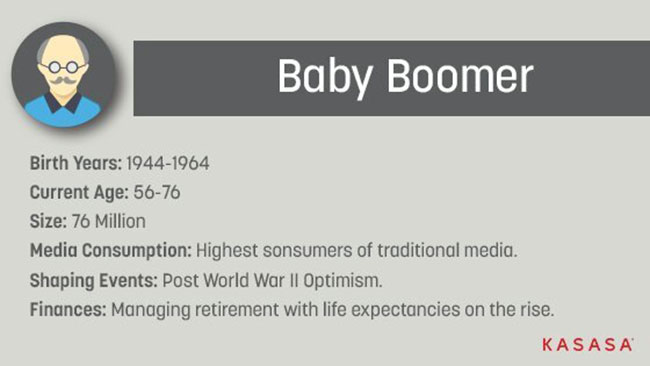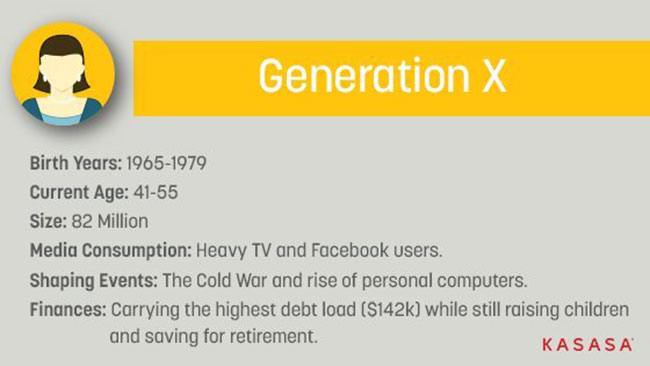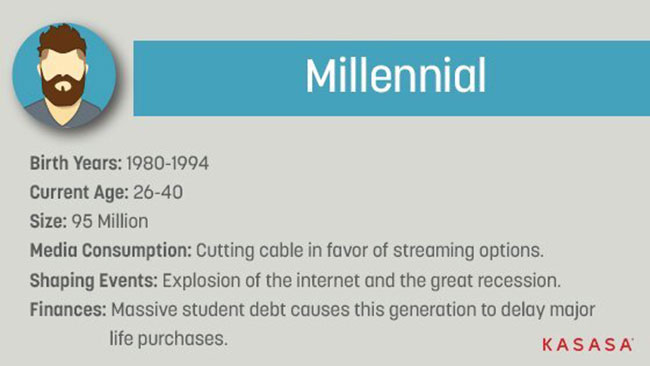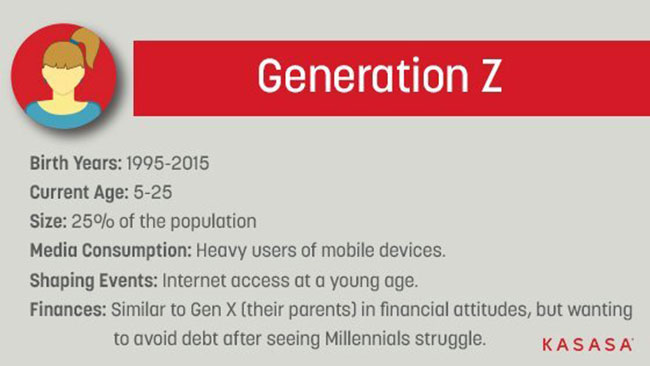|

by Kasasa
June 15,
2020
from
Kasaca Website

What
separates Generation Y from X,
and is
Generation Z a thing?
How old is each
generation?
Are they really
that different?
It’s easy to see why
there is so much confusion about generational cohorts.
If you’ve ever felt muddled by this "alphabet soup" of names…you’re
not alone. The real frustration hits when you realize that Gen Y
consumers will earn 46% of income in the U.S. by 2025.
And unless you understand
who they are and what they want, you won’t capture a dollar of their
money.
Furthermore, as one
generation’s spending power decreases (i.e. Boomers) another is
increasing.
People Grow
Older, Birthdays Stay the Same
A common source of confusion when labeling generations is their age.
Generational cohorts are defined (loosely) by birth year, not
current age.
The reason is simple,
generations get older in groups. If you think of all Millennials as
college kids (18 - 22), then you are thinking of a stage in
life and not a generation.
Millennials are out of
college and that life stage is now dominated by Gen Z.
Another example, a member of Generation X who turned 18 in 1998
would now be nearly 40. In that time, he or she cares about vastly
different issues and is receptive to a new set of marketing
messages. Regardless of your age, you will always belong to the
generation you were born into.
As of 2020, the breakdown by age looks like this:
-
Baby Boomers:
Baby boomers were born between 1944 and 1964. They're
current between 56-76 years old (76 million in U.S.)
-
Gen X: Gen
X was born between 1965 - 1979 and are currently between
41-55 years old (82 million people in U.S.)
-
Gen Y: Gen
Y, or Millennials, were born between 1980 and 1994. They are
currently between 26-40 years old.
-
Gen Z: Gen
Z is the newest generation to be named and were born between
1995 and 2015. They are currently between 5-25 years old
(nearly 74 million in U.S.)
The term "Millennial" has
become the popular way to reference both segments of Gen Y (more on
Y.1 and Y.2 below).
Realistically, the name
Generation Z is a place-holder for
the youngest people on the planet. It is likely to morph as they
leave childhood and mature into their adolescent and adult
identities.
Why are
generations named after letters?
It started with Generation X, people born between 1965-1979.
The preceding generation
was the Baby Boomers, born 1944-1964. Post World War II, Americans
were enjoying new-found prosperity, which resulted in a "baby boom."
The children born as a
result were dubbed the Baby Boomers.
But the generation that followed the Boomers didn’t have a blatant
cultural identifier. In fact, that’s the anecdotal origin of the
term Gen X — illustrating the undetermined characteristics they
would come to be known by.
Depending on whom you
ask, it was either sociologists, a novelist, or Billy Idol who
cemented this phrase in our vocabulary.
From there on it was all down-alphabet. The generation following Gen
X naturally became Gen Y, born 1980-1994 (give or take a few years
on either end). The term "Millennial" is widely credited to
Neil Howe, along with
William Strauss.
The pair coined the term
in 1989 when the impending turn of the millennium began to feature
heavily in the cultural consciousness.
Generation Z refers to babies born from the mid-2000s through today,
although the term isn’t yet widely used. This may signal the end of
‘alphabet soup’ (it does coincide with the literal end of the
alphabet, after all).
A flurry of potential
labels has appeared, including Gen Tech, post-Millennials,
iGeneration, and Gen Y-Fi.
Splitting Up
Gen Y
Javelin Research noticed that
not all Millennials are currently in the same stage of life.
While all millennials
were born around the turn of the century, some of them are still in
early adulthood, wrestling with new careers and settling down, while
the older millennials have a home and are building a family.
You can imagine how
having a child might change your interested and priorities, so for
marketing purposes, it's useful to split this generation into Gen
Y.1 and Gen Y.2.
Not only are the two groups culturally different, but they’re in
vastly different phases of their financial life. The younger group
are financial fledglings, just flexing their buying power.
The latter group has a
credit history, may have their first mortgage and are raising
toddlers. The contrast in priorities and needs is vast.
The same logic can be applied to any generation that is in this
stage of life or younger. As we get older, we tend to homogenize and
face similar life issues. The younger we are, the more dramatic each
stage of life is.
Consider the difference
between someone in elementary school and high school. While they
might be the same generation, they have very different views and
needs.
Marketing to young generations as a single cohort will not be nearly
as effective as segmenting your strategy and messaging.
Why are
generation cohort names important?
Each generation label serves as a short-hand to reference nearly 20
years of attitude, motivations, and historic events.
Few individuals
self-identify as Gen X, Millennial, or any other name.
They’re useful terms for marketers and have a tendency to trickle
down into common usage. Again, it’s important to emphasize that
referring to a cohort simply by the age range gets complicated
quickly.
10 years from now, the
priorities of Millennials will have changed - and marketing tactics
must adjust instep. Whatever terminology you use, the goal is to
reach people with marketing messages that are relevant to their
phase of life.
In short, no matter how
many letters get added to the alphabet soup, the most important
thing you can do is seek to understand the soup du jour for the type
of consumer you want to attract.
What makes
each generation different?
Before we dive into each generation, remember that the exact years
born are often disputed, but this should give you a general range to
help identify what generation you belong in.
The other fact to remember is that new technology is typically first
adopted by the youngest generation and then is gradually adopted by
the older generations.
As an example,
96% of Americans have a smartphone,
but Gen Z (the youngest generation) is the highest user.
The Baby
Boomer Generation

-
Boomer Birth
Years: 1944 to 1964
-
Current Age:
56 to 76
-
Generation
Size: 76 Million
-
Media
Consumption:
Baby boomers
are the biggest consumers of traditional media like
television, radio, magazines, and newspaper. Despite
being so traditional 90% of baby boomers have a Facebook
account. This generation has begun to adopt more
technology in order to stay in touch with family members
and reconnect with old friends.
-
Banking
Habits:
Boomers
prefer to go into a branch to perform transactions. This
generational cohort still prefers to use cash,
especially for purchases under $5.
-
Shaping
Events:
Post-WWII
optimism, the cold war, and the hippie movement.
-
What's next
on their financial horizon:
This
generation is experiencing the highest growth in student
loan debt. While this might seem counterintuitive, it
can be explained by the fact that this generation has
the most wealth and is looking to help their children
with their student debt. They have a belief that you
should take care of your children enough to set them on
the right course and don't plan on leaving any
inheritance. With more Americans outliving their
retirement fund, declining pensions, and social security
in jeopardy, ensuring you can successfully fund
retirement is a major concern for Boomers.
Generation X

-
Gen X Birth
Years: 1965 to 1979
-
Current Age:
41 to 55
-
Other
Nicknames: "Latchkey" generation, MTV generation
-
Generation
Size: 82 Million
-
Media
Consumption:
Gen X still
reads newspapers, magazines, listens to the radio, and
watches TV (about 165 hours worth of TV a month).
However, they are also digitally savvy and spend roughly
7 hours a week on Facebook (the highest of any
generational cohort).
-
Banking
Habits:
Since they
are digitally savvy, Gen X will do some research and
financial management online, but still prefer to do
transactions in person. They believe banking is a
person-to-person business and demonstrate brand loyalty.
-
Shaping
Events:
End of the
cold war, the rise of personal computing, and feeling
lost between the two huge generations.
-
What's next
on Gen X's financial horizon:
Gen X is
trying to raise a family, pay off student debt, and take
care of aging parents. These demands put a high strain
on their resources. The average Gen Xer carries $142,000
in debt, though most of this is in their mortgage. They
are looking to reduce their debt while building a stable
saving plan for the future.
Millennials
(Gen Y)

-
Millennial
Birth Years: 1980 to 1994
-
Current Age:
26 to 40
-
Other
Nicknames: Gen Y, Gen Me, Gen We, Echo Boomers
-
Generation
Size: 95 Million
-
Media
Consumption:
95% still
watch TV, but Netflix edges out traditional cable as the
preferred provider. Cord-cutting in favor of streaming
services is the popular choice. This generation is
extremely comfortable with mobile devices but 32% will
still use a computer for purchases. They typically have
multiple social media accounts.
-
Banking
Habits:
Millennials
have less brand loyalty than previous generations. They
prefer to shop product and features first and have
little patience for inefficient or poor service. Because
of this, Millennials place their trust in brands with
superior product history such as Apple and Google. They
seek digital tools to help manage their debt and see
their banks as transactional as opposed to relational.
-
Shaping
Events:
The Great
Recession, the technological explosion of the internet
and social media, and 9/11
-
What's next
on their financial horizon:
Millennials
are entering the workforce with high amounts of student
debt. This is delaying major purchases like weddings and
homes. Because of this financial instability,
Millennials prefer access over ownership which can be
seen through their preference for on-demand services.
They want partners that will help guide them to their
big purchases.
Gen Z

-
Gen Z Birth
Years: 1995 to 2019
-
Currently
Aged: 5 to 25
-
Other
Nicknames: iGeneration, Post-millennials, Homeland
Generation
-
Generation
Size: Roughly 25% of the population
-
Media
Consumption:
The average
Gen Zer received their first mobile phone at age 10.3
years. Many of them grew up playing with their parents'
mobile phones or tablets. They have grown up in a
hyper-connected world and the smartphone is their
preferred method of communication. On average, they
spend 3 hours a day on their mobile device.
-
Banking
Habits:
This
generation has seen the struggle of Millennials and has
adopted a more fiscally conservative approach. They want
to avoid debt and appreciate accounts or services that
aid in that endeavor. Debit cards top their priority
list followed by mobile banking. Over 50% have not
entered a bank branch in at least 3 months.
-
Shaping
Events:
Smartphones,
social media, never knowing a country not at war, and
seeing the financial struggles of their parents (Gen X).
-
What's next
on Gen Z's financial horizon:
Learning
about personal finance. They have a strong appetite for
financial education and are opening savings accounts at
younger ages than prior generations.
If you want to know more
about Gen Z, check out
this deep dive into their media
consumption and banking habits.
Do Generations
Use Technology Differently?
Younger generations have
often led older Americans in their adoption and use of technology,
and this largely holds true today.
Although Baby Boomers may trail Gen X and Millennials on native
technology usage, the rate at which Boomers expand their use of
technology is accelerated.
In fact, Boomers are now far more likely to own a smartphone than
they were in 2011 (68%
now vs. 25% then).
Do Generations
Bank Differently?
Absolutely, and for
several reasons.
-
Each generation
has been in the workforce for different lengths of time and
accumulated varying degrees of wealth.
-
Baby
Boomers have an average net worth of $1,066,000 and
a median net worth of $224,000.
-
GenXers
average net worth is around $288,700, but the median
is $59,800.
-
Millennials have an average net worth around
$76,200, but their median net worth is only $11,100
-
Gen Z's
average net worth is difficult to report on since so
much of the generation has no net worth or career.
-
Each generation
is preparing and saving for different life stages; be that
retirement, children's college tuition, or buying a first
car.
-
Each generation
grew up in evolving technological worlds and has unique
preferences in regard to managing financial relationships.
-
Each generation
grew up in different financial climates, which has informed
their financial attitudes and opinions of institutions.
|






